
Powerpoint Presentation 2007 ---- Basic
OBJECTIVESAfter completing this course you will be able to:
|
ABOUT THIS COURSEThis course includes:
|
Get to know your work space

¡@
¡@
 The slide pane
is the big area in the middle. You work directly on the slide in this
space.
The slide pane
is the big area in the middle. You work directly on the slide in this
space.
¡@
 On the slide, the boxes with the
dotted borders are called placeholders. Here's
where you type your text. Placeholders can also contain pictures,
charts, and other non-text items.
On the slide, the boxes with the
dotted borders are called placeholders. Here's
where you type your text. Placeholders can also contain pictures,
charts, and other non-text items.
¡@
 On the left are small, or thumbnail, versions of the slides in your
presentation, with the one you're working on highlighted. This area is
the Slides tab, and you can click the slide
thumbnails here to navigate to other slides, once you add them.
On the left are small, or thumbnail, versions of the slides in your
presentation, with the one you're working on highlighted. This area is
the Slides tab, and you can click the slide
thumbnails here to navigate to other slides, once you add them.
¡@
 In the bottom area is the notes pane, where you type the notes that you'll
refer to while you present. There's more room for the notes than shows
here.
In the bottom area is the notes pane, where you type the notes that you'll
refer to while you present. There's more room for the notes than shows
here.¡@

The most obvious way to add a new slide is by clicking New Slide, on the Home tab, as the picture shows. There are two ways to use this button.
 If you click the top part of the
button, where the slide icon is, a new slide is added immediately,
beneath the slide that's selected in the Slides tab.
If you click the top part of the
button, where the slide icon is, a new slide is added immediately,
beneath the slide that's selected in the Slides tab.
¡@
 If you click the bottom part of the
button, you get a gallery of layouts for the
slide. You choose a layout, and the slide is inserted with that layout.
If you click the bottom part of the
button, you get a gallery of layouts for the
slide. You choose a layout, and the slide is inserted with that layout.If you add a slide without choosing a layout, PowerPoint applies one automatically. You can easily change it, and you'll see how in the practice session.
¡@

A drop down menu shows and you click on "open".
Pick layouts for slides
¡@
The picture shows the layouts that PowerPoint starts with automatically.
 The Title Slide
layout, shown here as it looks in the layouts gallery, is applied to
the first slide in the show, the one that's already there when you
start.
The Title Slide
layout, shown here as it looks in the layouts gallery, is applied to
the first slide in the show, the one that's already there when you
start.
¡@
 On the slide, the Title Slide layout
contains placeholders for a title and subtitle.
On the slide, the Title Slide layout
contains placeholders for a title and subtitle.
¡@
 The layout you'll probably use the
most for other slides is called Title and Content,
shown here as it looks in the layouts gallery.
The layout you'll probably use the
most for other slides is called Title and Content,
shown here as it looks in the layouts gallery.
¡@
 On the slide, this layout has a
placeholder for the slide title, and a second, all-purpose placeholder
that contains text as well as several icons. This placeholder supports
either text or graphic elements like charts, pictures, and movie files.
On the slide, this layout has a
placeholder for the slide title, and a second, all-purpose placeholder
that contains text as well as several icons. This placeholder supports
either text or graphic elements like charts, pictures, and movie files.Some of the other layouts have two of these all-purpose placeholders, so you could put a list in one and a picture or other graphic in the other.
You'll work more with layouts when you practice.
Type your text
The default formatting for text is a bulleted list.
 You can use different levels of text
within bulleted lists to make minor points under major points.
You can use different levels of text
within bulleted lists to make minor points under major points.
¡@
 On the Ribbon, use commands in the Font group to change character formatting, such as font
color and size.
On the Ribbon, use commands in the Font group to change character formatting, such as font
color and size.
¡@
 Use commands in the Paragraph
group to change paragraph formatting, such as list formatting, degree
of text indentation, and line spacing.
Use commands in the Paragraph
group to change paragraph formatting, such as list formatting, degree
of text indentation, and line spacing.Automatic text fit If you type more text than fits in the placeholder, PowerPoint reduces the font size and line spacing to fit it all in. You can turn this behavior off, if you prefer. You'll see how in the practice session.
Insert slides from another presentation
¡@
¡@
 On the Home tab,
click the arrow next to New Slide, as if you were
going to insert a new slide and choose a layout for it first.
On the Home tab,
click the arrow next to New Slide, as if you were
going to insert a new slide and choose a layout for it first.
¡@
 Below the layout gallery, click Reuse Slides.
Below the layout gallery, click Reuse Slides.
¡@
 In the Reuse Slides
task pane, under Insert slide from, click Browse to find the presentation or slide library that
has the slides you want. Then click the arrow to open those slides in
the task pane.
In the Reuse Slides
task pane, under Insert slide from, click Browse to find the presentation or slide library that
has the slides you want. Then click the arrow to open those slides in
the task pane.
¡@
 When you find the slide you want,
take notice of the Keep source formatting check box,
at the very bottom of the pane. If you want to retain the exact look of
the slides you're inserting, be sure this check box is selected before
you insert the slide.
When you find the slide you want,
take notice of the Keep source formatting check box,
at the very bottom of the pane. If you want to retain the exact look of
the slides you're inserting, be sure this check box is selected before
you insert the slide.
¡@
 Click each slide you want to insert.
Each one is copied into the open presentation, below the currently
selected slide or below your cursor, if you've positioned it beneath a
slide thumbnail.
Click each slide you want to insert.
Each one is copied into the open presentation, below the currently
selected slide or below your cursor, if you've positioned it beneath a
slide thumbnail.If you don't select Keep source formatting, the inserted slides inherit the look, or theme, that your current slides use. (The theme is what dictates the overall design and colors for the presentation; more about that in the next lesson.)
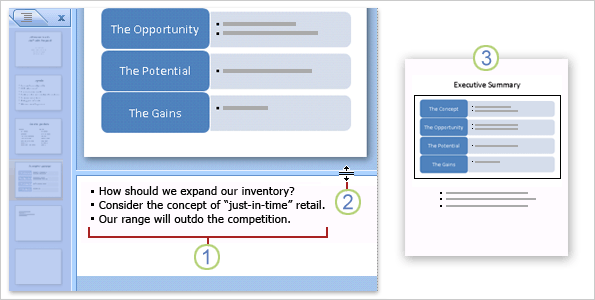
Use speaker notes to elaborate on the points on the slide. Good notes can help you keep your audience engaged and prevent text overload on the slide.
 As
you develop the content on your slides, type your notes in the notes
pane, below the slide. Typically, as a presenter, you print these notes
and refer to them as you give the presentation.
As
you develop the content on your slides, type your notes in the notes
pane, below the slide. Typically, as a presenter, you print these notes
and refer to them as you give the presentation. You can enlarge the notes pane so
that it's easier to work in by dragging the split bar.
You can enlarge the notes pane so
that it's easier to work in by dragging the split bar. Your notes are saved in a notes page, which contains a copy of the
slide along with the notes. This is what you print to refer to during
the show.
Your notes are saved in a notes page, which contains a copy of the
slide along with the notes. This is what you print to refer to during
the show.You'll see how to view and edit the notes page in the practice session.
There is a space limit If your notes exceed the space on the notes page, they will get cut off when you print. You'll see how to prevent this in the lesson "Proof, print, prep for the show."
As you create a show, preview it at any time in Slide Show view. This view gives you an idea of how the slides will look and behave when projected.
 To open Slide Show view, click the Slide Show tab, and click a command in the Start Slide Show group — to start on the
first slide or the current slide.
To open Slide Show view, click the Slide Show tab, and click a command in the Start Slide Show group — to start on the
first slide or the current slide. Slide Show view fills your computer
screen.
Slide Show view fills your computer
screen. One
way to navigate from slide to slide is to use the Slide Show toolbar,
at the bottom of the screen, on the left. It has navigational arrows
that appear when you position the cursor in that area. (You'll see this
toolbar better in the practice session.) Another way to move from slide
to slide is simply to click the mouse button.
One
way to navigate from slide to slide is to use the Slide Show toolbar,
at the bottom of the screen, on the left. It has navigational arrows
that appear when you position the cursor in that area. (You'll see this
toolbar better in the practice session.) Another way to move from slide
to slide is simply to click the mouse button. To
get out of Slide Show view at any point, press ESC. This returns you to
the view you left, which is typically Normal view. There, you can make
necessary changes to slides, and then preview the slide show again.
To
get out of Slide Show view at any point, press ESC. This returns you to
the view you left, which is typically Normal view. There, you can make
necessary changes to slides, and then preview the slide show again.
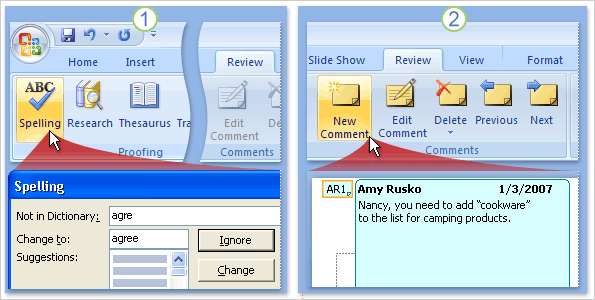
You'll want to weed out any spelling errors and find other goofs and gaps before you present. Go to the Review tab on the Ribbon to run a spelling check. That's also where others can go to add comments as they review your slides.
 On the Review tab,
in the Proofing group, click Spelling,
and make selections as the spelling checker moves through your slides.
On the Review tab,
in the Proofing group, click Spelling,
and make selections as the spelling checker moves through your slides. You might also want to have others
review the presentation and make comments before you present. You'll
find the New Comment command in the Comments
group, also on the Review
tab. A person adding comments just clicks the command and types the
comment, slide by slide. When you review the comments, you use Previous and Next, in the Comments group, to navigate through them.
You might also want to have others
review the presentation and make comments before you present. You'll
find the New Comment command in the Comments
group, also on the Review
tab. A person adding comments just clicks the command and types the
comment, slide by slide. When you review the comments, you use Previous and Next, in the Comments group, to navigate through them.If you do have others review the presentation, PowerPoint helps the process by automatically attaching the presentation to an e-mail message.
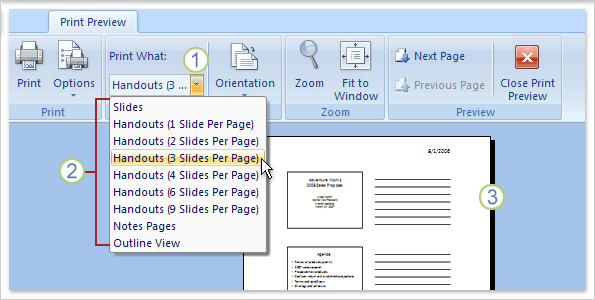
The most common type of PowerPoint printout for audiences is called a handout. Handouts can have one or several slides per page, up to nine.
A good practice is to use Print Preview to select the handout type you want, as shown here, so you can see how it will look before printing. (Start by clicking Print Preview on the Microsoft Office Button menu.)
 In Print Preview,
display the list in the Print What box by clicking
the arrow.
In Print Preview,
display the list in the Print What box by clicking
the arrow. Choose one of the handout types from
the list.
Choose one of the handout types from
the list. When
you click the handout type, you are shown a preview of how your slides
will look when printed in this format. You can navigate through all the
handout pages.The handout type that has three slides per page also
includes lines for audience notes.
When
you click the handout type, you are shown a preview of how your slides
will look when printed in this format. You can navigate through all the
handout pages.The handout type that has three slides per page also
includes lines for audience notes.When you're ready to print, you click Print.
Note You do not have to select handouts in Print Preview; you can just open the Print dialog box from the Microsoft Office Button menu, and select the handout type there.
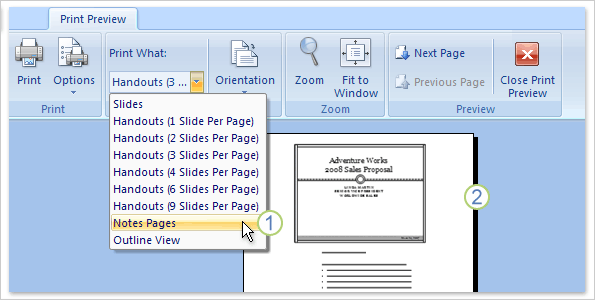
You've printed handouts to give to your audience; now print speaker notes for yourself, which you can refer to as you present.
It's a good practice to look at your speaker notes before you print them. See if they look as you're expecting them to. Start by clicking Print Preview on the Microsoft Office Button (logo) menu.
 To print your speaker notes, select Notes Pages in the Print What list.
To print your speaker notes, select Notes Pages in the Print What list. Your notes pages are shown in the
preview window, starting with the first slide (unless you specify
otherwise).
Your notes pages are shown in the
preview window, starting with the first slide (unless you specify
otherwise).If you find that something isn't formatted as you'd intended or you see that note text has been cut off (as it will be if it exceeds the room in the text placeholder), you need to fix the notes either in Notes Page view or in Normal view.
After you've checked your notes and you're ready to print, you click Print.
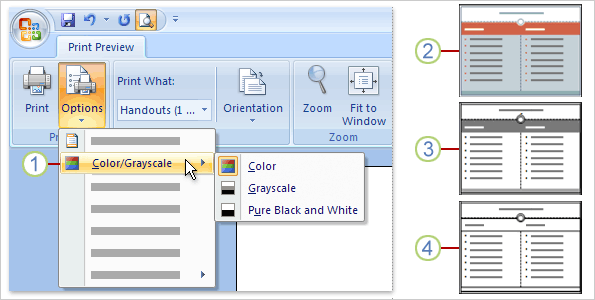
Depending on what kind of printer your computer is hooked up to, you can print your presentation in Color; in Grayscale, which consists of various tones of gray combined with black and white; or in Pure Black and White, which eliminates most of the grays and will use the least printer ink.
This is how you select an option for printing:
 Under Print Preview,
click Options, and point to Color/Grayscale.
Then select from the menu. Your slides will be previewed and printed
with that choice applied. Note that if you are printing to a black and
white printer, the Color option becomes Color (On Black and White Printer), and all the slide's
colors are rendered using black, white, and shades of gray.
Under Print Preview,
click Options, and point to Color/Grayscale.
Then select from the menu. Your slides will be previewed and printed
with that choice applied. Note that if you are printing to a black and
white printer, the Color option becomes Color (On Black and White Printer), and all the slide's
colors are rendered using black, white, and shades of gray. The first preview example shows a
slide that will be printed in color.
The first preview example shows a
slide that will be printed in color. The
second preview example shows a slide that will be printed in grayscale.
While the background is made white, some areas reflect color, such as
the horizontal banners under the title and along the bottom of the
slide.
The
second preview example shows a slide that will be printed in grayscale.
While the background is made white, some areas reflect color, such as
the horizontal banners under the title and along the bottom of the
slide. And the last preview example shows a
slide that will be printed in pure black and white.
And the last preview example shows a
slide that will be printed in pure black and white.Start a new
presentation with at least 3
slides, pick a different layout for each slide, then add text and
speaker notes
on 2 of the slides.
This assignment is due
in the dropbox before
5pm on Feb 2nd, 2010.